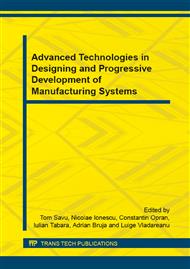p.75
p.81
p.87
p.93
p.99
p.105
p.111
p.117
p.123
An Algorithm for Generating Product’s Structure in a Simulation Framework
Abstract:
The paper is describing an algorithm for randomly generating the orders received by a simulated manufacturing system. Based on a previously defined Petri Net type representation of the product, there is presented the proposed structure generation algorithm.The algorithm was implemented in a graphical programming environment which will serve also for developing the manufacturing system simulator, so the paper is describing the procedures for generating the records from the proposed data structure.Running the implemented procedure generated a product’s structure with the main components graphically represented complying with the data definition to be used in the simulation framework.
Info:
Periodical:
Pages:
99-104
Citation:
Online since:
May 2015
Authors:
Price:
Сopyright:
© 2015 Trans Tech Publications Ltd. All Rights Reserved
Share:
Citation:


